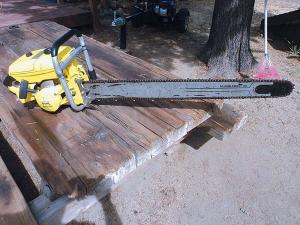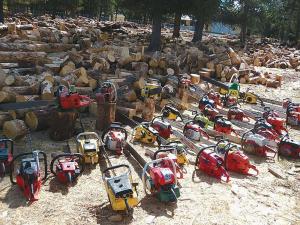Oregon Logger Makes His Own Chainsaws
Terry Brannon has been an Oregon logger since the early 1980’s, and for the past 20 years he’s built his own chainsaws. “There’s not a piece of plastic anywhere on the saws I build,” says Brannon. “They’re all metal and they’ll run for 50 years. They’ll run in 10 ft. of snow, in 10 ft. of water, and even if you drop them 10 ft. from a tree.”
Brannon’s claims are reinforced by the fact he owns and regularly uses more than 100 working McCulloch and other brand saws. “I don’t build shelf queens, garage queens or show saws,” says Brannon. “They’re all made to work for a living, not sit around for a pretty picture.” Brannon uses different saws for different jobs and carries about 20 with him every time he heads into the woods, which is almost every day.
“When a logger’s on the job, the saw has to work, because there’s no time to run for parts,” he says. “I can be 10, 20 or 50 miles into the timber, so I build every one of my saws to operate in tough conditions. I seldom if ever have a saw quit.”
Brannon has that iron-clad assurance because he builds all his saws from the base of the handle to the tip of the bar. He says he’s built and rebuilt every model of McCulloch and Homelite saws that the companies have made since 1980. His stable of saws also includes a few Stihls, Homelites and a classic Pioneer. “Most guys will need 4 days just to take a saw apart because they don’t have the tools or the know-how,” Brannon says. “I’ve been doing this so long I can build an entirely new saw in about 3 days.” Before building saws he spent several years building car engines.
The saw models he builds are usually 125cc’s and larger, the size needed to power through large timber in the Pacific Northwest. Says Brannon, “Out here we need that power because trees can be 2 to 3 ft. in diameter. Old growth deadfall, which I’m called to cut away from power lines or roads, can be 52 in. or more in diameter. I have bars ranging from 28 in. to 48 in. for my saws.”
Although he doesn’t often use a computer, Brannon does use Facebook (Cascade Saw Restoration) to show and describe the saws he builds. A few examples include a Super 797 McCulloch with the SDC kit and a CP muffler with a 42-in. Oregon roller bar and 404 63 guage chain; A rebuilt Homelite 2100-S with a 114cc upgrade. He used an oversized piston and rod, and fabbed a new muffler; A rebuilt Stihl 056 Magnum II. It had a bad ignition and with no SEM/Bosch ignition on the market, he gutted a Husky 2100 for the SEM.
Brannon gets his parts from old saws that he buys from retired loggers or finds at garage and yard sales. Most of those have been sitting for months or years and they’re a good bargain. If he buys a running saw, he pays a good price if the piston and cylinder walls are in good condition. He sells custom-built saws for prices ranging from $800 to $1,200. The higher priced ones are completely re-painted with Zolonite direct-to-metal paint, have 3 coats of clear-coat sealer and look brand new.
“People from across the country contact me to fix saws, but I don’t do any of that type work,” Brannon says. “My customer is the guy who wants a saw that will outlive him, his house and his family.”
Contact: FARM SHOW Followup, Terry Brannon, Cascade Saw Restoration, 52880 Wayside Loop, La Pine, Ore. 97739 (ph 541 771-1962).

Click here to download page story appeared in.
Click here to read entire issue
Oregon Logger Makes His Own Chainsaws SPECIALTY/SERVICES Terry Brannon has been an Oregon logger since the early 1980’s and for the past 20 years he’s built his own chainsaws “There’s not a piece of plastic anywhere on the saws I build ” says Brannon “They’re all metal and they’ll run for 50 years They’ll run in 10 ft of snow in 10 ft of water and even if you drop them 10 ft from a tree ” Brannon’s claims are reinforced by the fact he owns and regularly uses more than 100 working McCulloch and other brand saws “I don’t build shelf queens garage queens or show saws ” says Brannon “They’re all made to work for a living not sit around for a pretty picture ” Brannon uses different saws for different jobs and carries about 20 with him every time he heads into the woods which is almost every day “When a logger’s on the job the saw has to work because there’s no time to run for parts ” he says “I can be 10 20 or 50 miles into the timber so I build every one of my saws to operate in tough conditions I seldom if ever have a saw quit ” Brannon has that iron-clad assurance because he builds all his saws from the base of the handle to the tip of the bar He says he’s built and rebuilt every model of McCulloch and Homelite saws that the companies have made since 1980 His stable of saws also includes a few Stihls Homelites and a classic Pioneer “Most guys will need 4 days just to take a saw apart because they don’t have the tools or the know-how ” Brannon says “I’ve been doing this so long I can build an entirely new saw in about 3 days ” Before building saws he spent several years building car engines The saw models he builds are usually 125cc’s and larger the size needed to power through large timber in the Pacific Northwest Says Brannon “Out here we need that power because trees can be 2 to 3 ft in diameter Old growth deadfall which I’m called to cut away from power lines or roads can be 52 in or more in diameter I have bars ranging from 28 in to 48 in for my saws ” Although he doesn’t often use a computer Brannon does use Facebook Cascade Saw Restoration to show and describe the saws he builds A few examples include a Super 797 McCulloch with the SDC kit and a CP muffler with a 42-in Oregon roller bar and 404 63 guage chain; A rebuilt Homelite 2100-S with a 114cc upgrade He used an oversized piston and rod and fabbed a new muffler; A rebuilt Stihl 056 Magnum II It had a bad ignition and with no SEM/Bosch ignition on the market he gutted a Husky 2100 for the SEM Brannon gets his parts from old saws that he buys from retired loggers or finds at garage and yard sales Most of those have been sitting for months or years and they’re a good bargain If he buys a running saw he pays a good price if the piston and cylinder walls are in good condition He sells custom-built saws for prices ranging from $800 to $1 200 The higher priced ones are completely re-painted with Zolonite direct-to-metal paint have 3 coats of clear-coat sealer and look brand new “People from across the country contact me to fix saws but I don’t do any of that type work ” Brannon says “My customer is the guy who wants a saw that will outlive him his house and his family ” Contact: FARM SHOW Followup Terry Brannon Cascade Saw Restoration 52880 Wayside Loop La Pine Ore 97739 ph 541 771-1962








